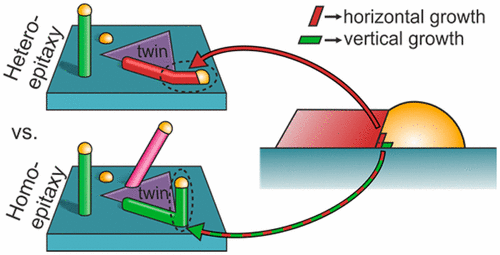Our official English website, www.x-mol.net, welcomes your
feedback! (Note: you will need to create a separate account there.)
Impact of Rotational Twin Boundaries and Lattice Mismatch on III–V Nanowire Growth
ACS Nano ( IF 15.8 ) Pub Date : 2017-09-13 00:00:00 , DOI: 10.1021/acsnano.7b01228 Matthias Steidl 1 , Christian Koppka 1 , Lars Winterfeld 2 , Katharina Peh 1 , Beatriz Galiana 3 , Oliver Supplie 1 , Peter Kleinschmidt 1 , Erich Runge 2 , Thomas Hannappel 1
ACS Nano ( IF 15.8 ) Pub Date : 2017-09-13 00:00:00 , DOI: 10.1021/acsnano.7b01228 Matthias Steidl 1 , Christian Koppka 1 , Lars Winterfeld 2 , Katharina Peh 1 , Beatriz Galiana 3 , Oliver Supplie 1 , Peter Kleinschmidt 1 , Erich Runge 2 , Thomas Hannappel 1
Affiliation

|
Pseudomorphic planar III–V transition layers greatly facilitate the epitaxial integration of vapor–liquid–solid grown III–V nanowires (NW) on Si(111) substrates. Heteroepitaxial (111) layer growth, however, is commonly accompanied by the formation of rotational twins. We find that rotational twin boundaries (RTBs), which intersect the surface of GaP/Si(111) heterosubstrates, generally cause horizontal NW growth and may even suppress NW growth entirely. Away from RTBs, the NW growth direction switches from horizontal to vertical in the case of homoepitaxial GaP NWs, whereas heteroepitaxial GaAs NWs continue growing horizontally. To understand this rich phenomenology, we develop a model based on classical nucleation theory. Independent of the occurrence of RTBs and specific transition layers, our model can generally explain the prevalent observation of horizontal III–V NW growth in lattice mismatched systems and the high crystal quality of horizontal nanowires.
中文翻译:

旋转孪晶边界和晶格失配对III–V纳米线生长的影响
拟晶态平面III–V过渡层极大地促进了Si(111)衬底上汽-液-固生长的III-V纳米线(NW)的外延集成。然而,异质外延(111)层的生长通常伴随着旋转孪晶的形成。我们发现,与GaP / Si(111)异质衬底表面相交的旋转孪晶边界(RTB)通常会导致水平NW生长,甚至可能完全抑制NW生长。在同质外延GaP NW的情况下,NW的生长方向远离RTB,从水平方向变为垂直方向,而异质外延GaAs NW继续水平方向生长。为了理解这种丰富的现象学,我们开发了基于经典成核理论的模型。与实时出价工具和特定过渡层的出现无关,
更新日期:2017-09-14
中文翻译:

旋转孪晶边界和晶格失配对III–V纳米线生长的影响
拟晶态平面III–V过渡层极大地促进了Si(111)衬底上汽-液-固生长的III-V纳米线(NW)的外延集成。然而,异质外延(111)层的生长通常伴随着旋转孪晶的形成。我们发现,与GaP / Si(111)异质衬底表面相交的旋转孪晶边界(RTB)通常会导致水平NW生长,甚至可能完全抑制NW生长。在同质外延GaP NW的情况下,NW的生长方向远离RTB,从水平方向变为垂直方向,而异质外延GaAs NW继续水平方向生长。为了理解这种丰富的现象学,我们开发了基于经典成核理论的模型。与实时出价工具和特定过渡层的出现无关,











































 京公网安备 11010802027423号
京公网安备 11010802027423号